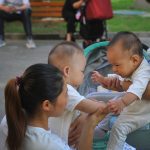With lower fertility intentions, China’s population to see negative growth before 2025: National Health Commission
国家卫健委:生育意愿降低,2025年前中国人口将出现负增长
2022年8月1日,国家卫健委党组在求是杂志发表《谱写新时代人口工作新篇章》一文指出,随着长期累积的人口负增长势能进一步释放,我国总人口增速明显放缓,“十四五”期间将进入负增长阶段。
文章指出,2021年国家卫生健康委调查显示,育龄妇女生育意愿继续走低,平均打算生育子女数为1.64个,低于2017年的1.76个和2019年的1.73个,作为生育主体的“90后”、“00后”仅为1.54个和1.48个。经济负担重、子女无人照料和女性对职业发展的担忧等因素已经成为制约生育的主要障碍。
A year after the country made a comprehensive plan for demographic structure, China’s National Health Commission (NHC) released a report on Monday pointing out that women of child-bearing age have a low desire to have children, and the total population will see negative growth during the 14th Five-Year plan (2021-25) period, adding that the population’s development is facing profound change, where an aging society with fewer children will become the new normal.
Experts believe that it is the first time that the Chinese government made such a public announcement, which shows its determination to tackle the population problem, and bringing fertility rates up to the international average must be achieved, and the sooner it starts, the better.
The NHC published an article entitled “Writing a new chapter in population work in the new era” on Qiushi Journal, a flagship magazine of the Communist Party of China Central Committee on Monday, in which it pointed out that factors such as heavy financial burdens, child care and women’s worries about career development have become major obstacles to childbearing.
The growth rate of the total population will slow down significantly, and in the 14th Five-Year Plan period, it will enter a negative growth stage, the report said. In recent years, the total fertility rate has dropped below 1.3. The low fertility rate has become the most important risk affecting the balanced development of China’s population.

In addition, with the deepening of the degree of aging, it is expected that the country will enter the stage of severe population aging around 2035, when those 60 years old and above will account for over 30 percent of the total population. According to the report, in 2020, the average family size decreased to 2.62 persons, 0.48 fewer than in 2010, and the functions of elder care and childcare were weakened.
The contradiction between the population and development remains acute in some areas with fragile ecosystems and scarce resources.
Chinese demographers have predicted that negative population growth will be the dominant trend in the coming years for a long time, and improving the overall quality of the population and changing economic development plans are vital to address the problem.
“In the past, we focused on population control, but now we should focus on raising the appropriate level of fertility, improving the quality of the population and the population structure, optimizing the population distribution, and promoting long-term and balanced population development,” the NHC said in the article.
China used to rely on its demographic dividend to drive economic development, Lu Jiehua, a professor of sociology at Peking University, told the Global Times in a previous interview.
“In this case, China should explore advantages in areas beyond the demographic dividend to fully improve the overall quality of the population and create new conditions for economic development,” said Lu.
The NHC said that it is time to review and abolish relevant restrictive measures, make the fertility policy more inclusive, improve comprehensive services for child-rearing, and introduce active support measures to effectively reduce the burden on the people and enhance the ability of families to develop.
The NHC stressed that China should establish and improve support for childbearing as soon as possible and policies on housing, education, healthcare, employment, taxation and social security should be appropriately tilted toward families having children to reduce the burden of childbearing, create a child-friendly social atmosphere, and stimulate families’ willingness to have children.


-150x150.jpg)





